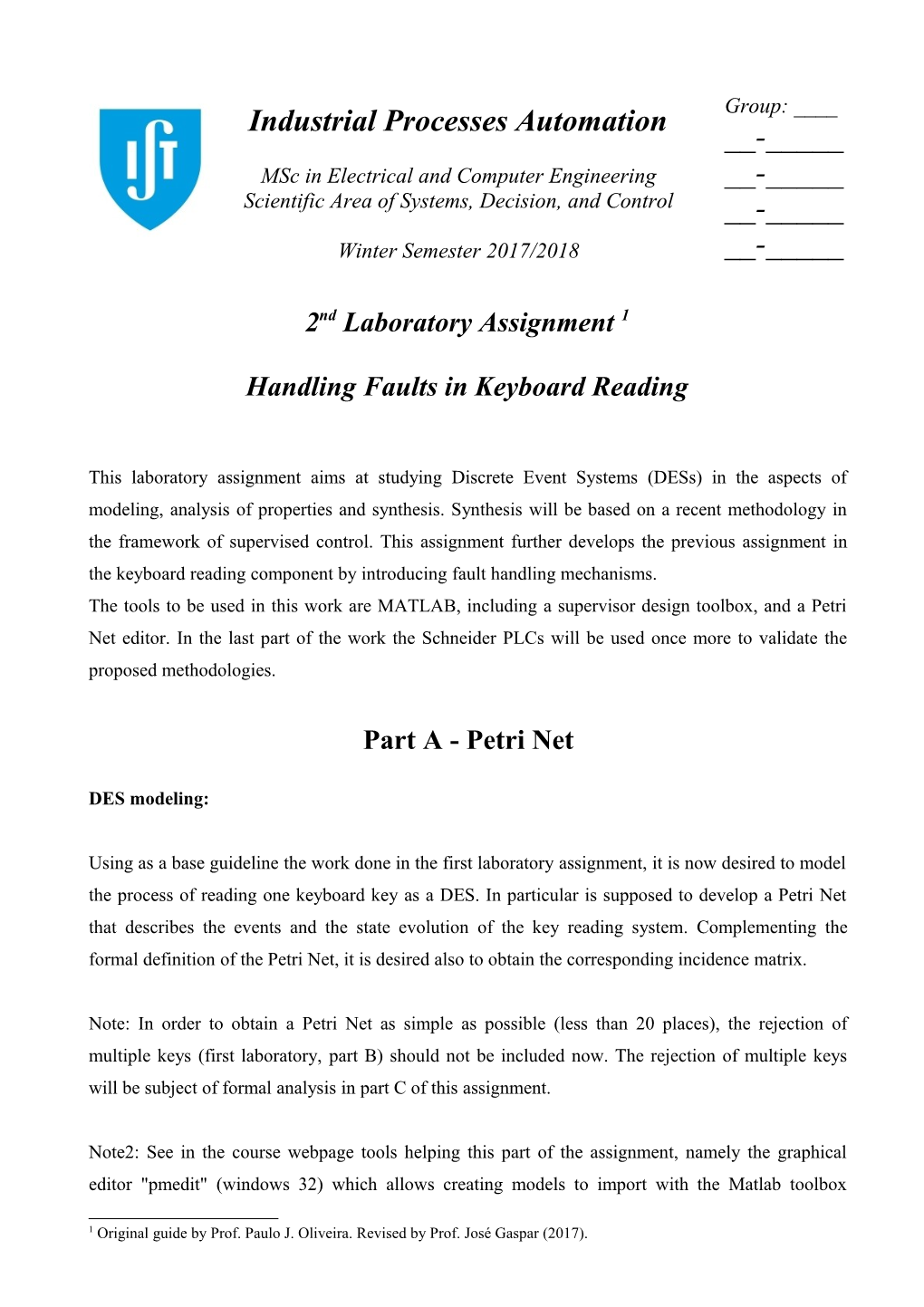MSc in Electrical and Computer Engineering
Scientific Area of Systems, Decision, and Control
Winter Semester 2017/2018 / Group: ____
__-_____
__-_____
__-_____
__-_____
2nd Laboratory Assignment [1]
Handling Faults in Keyboard Reading
This laboratory assignment aims at studying Discrete Event Systems (DESs) in the aspects of modeling, analysis of properties and synthesis. Synthesis will be based on a recent methodology in the framework of supervised control. This assignment further develops the previous assignment in the keyboard reading component by introducing fault handling mechanisms.
The tools to be used in this work are MATLAB, including a supervisor design toolbox, and a Petri Net editor. In the last part of the work the Schneider PLCs will be used once more to validate the proposed methodologies.
Part A - Petri Net
DES modeling:
Using as a base guideline the work done in the first laboratory assignment, it is now desired to model the process of reading one keyboard key as a DES. In particular is supposed to develop a Petri Net that describes the events and the state evolution of the key reading system. Complementing the formal definition of the Petri Net, it is desired also to obtain the corresponding incidence matrix.
Note: In order to obtain a Petri Net as simple as possible (less than 20 places), the rejection of multiple keys (first laboratory, part B) should not be included now. The rejection of multiple keys will be subject of formal analysis in part C of this assignment.
Note2: See in the course webpage tools helping this part of the assignment, namely the graphical editor "pmedit" (windows 32) which allows creating models to import with the Matlab toolbox "tpn5". Both tools are compressed in a single ZIP file "PN_editor_MATLAB_sim_and_Manual.zip". See also Matlab functions simulating Petri nets, in particular the "5 Philosophers" demo and a template for simulating the keyboard "lab2_sim_kb_v6.zip".
Q1: Write the list of events of the DES you are proposing. (Fill the next table, adding as many lines as needed).
Event Identifier / DescriptionQ2: Write the list of conditions of the DES you are proposing. (Fill the next table, adding as many lines as needed).
Condition Identifier / DescriptionQ3: Write the table of pre and post conditions for each of the events. (Fill the next table, adding as many lines as needed).
Event / Pre-Conditions / Post-ConditionsQ4: Draw the corresponding Petri Net. Comment about the temporizations implemented in the first assignment and which are not currently included in the proposed DES.
Q5: Obtain the incidence matrix, D=D+-D-, describing the proposed Petri Net.
Q6: [PN simulation] Simulate the Petri net you proposed in the previous questions. Comment whether your simulation has, or does not have, privileged places or transitions while receiving random inputs. As helping references see the template for simulating the keyboard "lab2_sim_kb_v6.zip" and the "5 philosophers dinner" simulation referred in Annex 1.
Q7: [PLC test] Run the demonstration of the Petri nets to PLC code converter, named tst1_blink_on_off.m, provided in the course webpage (see Annex 2). Draw the Petri net considered in the demonstration. Discuss whether this demonstration has, or not, privileged places or transitions. Describe the main parts of the structured text generated by the code converter.
Annex 1 - Philosophers Dinner Petri Net Simulation
Please find in the webpage of the course the "5 philosophers dinner" simulation files as a zip file. Decompress the zip file and run pdinner_tst.m. Note that you need also the RDP.M function found in the tpn5 toolbox that you must install beforehand.
The pdinner_tst.m demonstration script loads a Petri net model shown in figure1 and built using PMEDIT. The Petri net model is read using the referred RDP.M function.
Figure 1: Petri net model representing the 5 philosophers dinner problem.
The default simulation has the transitions scheduled, driven by a time table. In order to run a simulation where the transitions are driven randomly, you can edit the file PN_tfire.m and replace the line:
qk= pdinner_IO(act, t);
by the line:
qk= round(rand(1,5)); qk= [qk not(qk)];
Note that only transitions 1 till 5 are computed randomly. Transitions 6 till 10 are defined simply as the negation of the transitions 1 till 5.
To have more information on the Petri net simulator and the specific simulation of the "5 philosophers dinner" see:
http://users.isr.ist.utl.pt/~jag/course_utils/pn_sim/PN_sim.html
Annex 2 - Convert a Petri net to a PLC program
In this annex is detailed the download and test of a converter of a Petri net to a PLC program. A demonstration example is included. The converter is written and runs in Matlab.
Please find in the webpage of the course the "Petri net compiler & demo" as a zip file. Decompress the zip file, change to folder ./tst1_blink_turn_on_off/ and run tst1_blink_on_off.m . Note that the compiler is in folder ./pn_to_plc_compiler/ which is going to be asked you the first time you run de demonstration.
Figure 1: Selection of the hardware configuration.
In the first run of tst1_blink_on_off.m it is asked the hardware configuration. Two configurations are considered, namely the "s2_DEY16D2_s4_DSY16T2" and the "s3_DMY28FK" (see figure 1). Configuration "s2_DEY16D2_s4_DSY16T2" means the PLC has two modules, at slots two and four, and the modules are named "DEY16D2" and "DSY16T2". Configuration "s3_DMY28FK" means the PLC has only the module "DMY28FK" mounted at slot three. In case you want to revisit this configuration you can either restart Matlab or run the command clear global.
After running the demonstration, you obtain file tst1_mk_program_res.txt containing structured text code that you can copy into a Unity project. Within the Unity project you need to do declare some additional variables like the timer names, timing values and flags. Please see more details in the text file ./tst1_blink_turn_on_off/_readme.txt .
To have more information on the Petri net to PLC code converter see:
http://users.isr.ist.utl.pt/~jag/course_utils/pn_to_plc/pn_to_plc.html
[1] Original guide by Prof. Paulo J. Oliveira. Revised by Prof. José Gaspar (2017).
